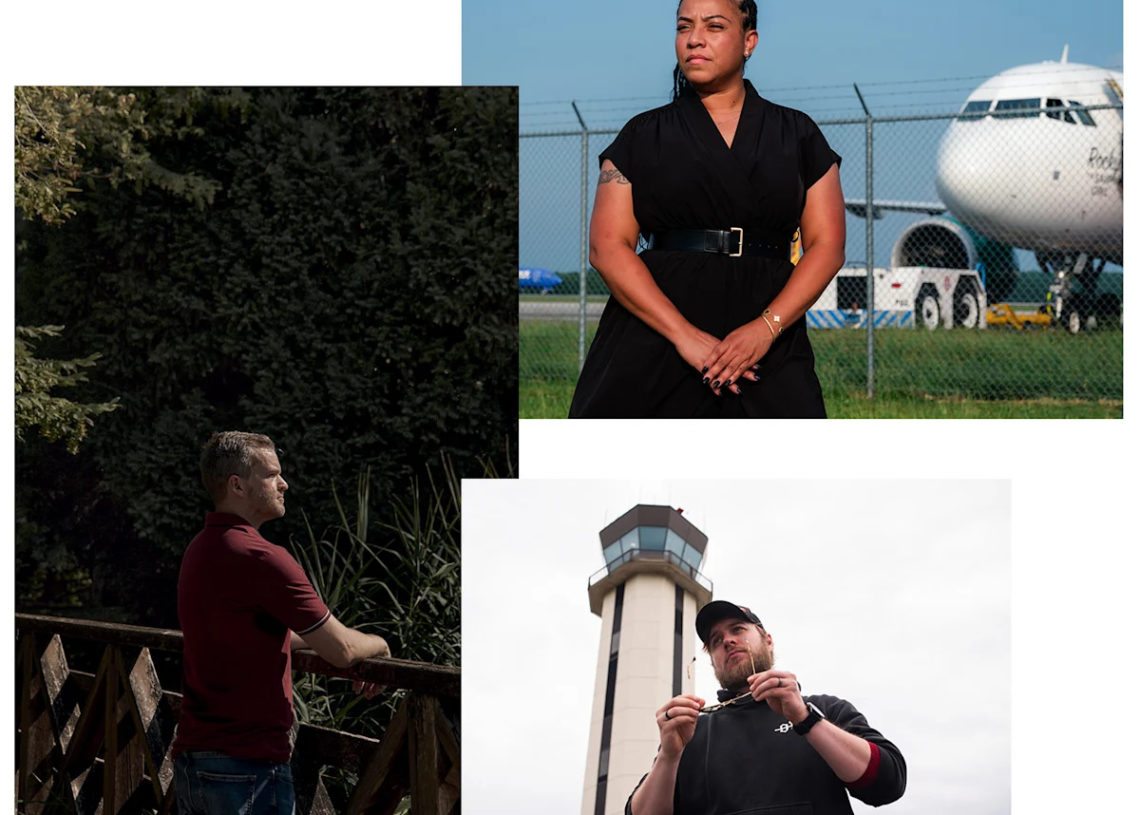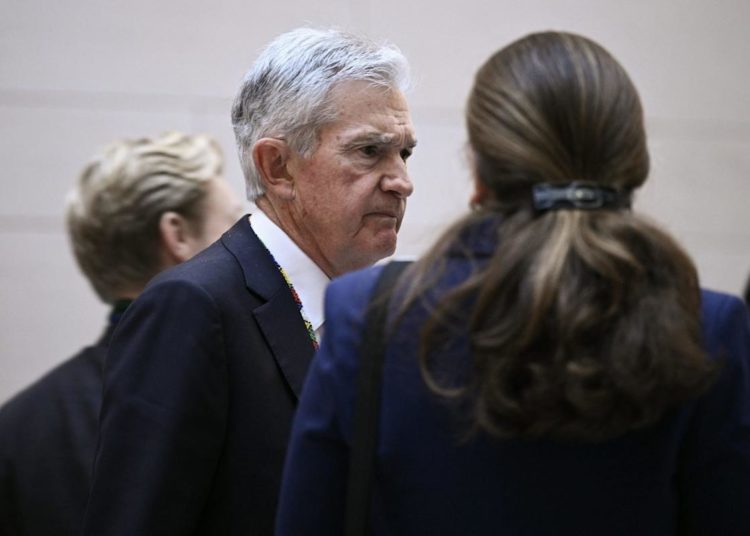In his first few days guiding aircraft at the Oakland, California, air traffic control center, trainee Ryan Higgins deleted a plane’s data from the radar screen. It was untrackable for a few frantic moments while more experienced controllers made sure the plane was on a safe path. The rookie mistake rattled Higgins and earned him a stern rebuke.
By that point, Higgins, a promising candidate with a college degree, already felt slighted by the veteran Federal Aviation Administration controllers who are responsible for training recruits under the agency’s apprenticeship system. He witnessed another trainee get cursed out in front of his peers. He found the center’s equipment outdated, with technology that he said made it difficult to understand pilots’ communications. And for all the stress, the payoff – after at least three years of training – would be working in a job marked by six-day workweeks.
He quit.
“I just felt kind of miserable going to work and being berated when I’m just trying to learn,” said Higgins, who was 28 when he first arrived at the Oakland center, which guides thousands of passenger planes a day along busy West Coast air routes.
Higgins’s experience was far from unusual, according to a Washington Post examination of data and interviews with trainees who pursued a career in the federal system but ultimately washed out. The FAA’s high trainee dropout rate is a leading cause of the nation’s dangerous shortage of air traffic controllers. In some cases, recruits failed their training and were dismissed. In others, they left of their own accord rather than endure what they described as haphazard instruction, organizational dysfunction and abusive conditions.
The agency employs about 11,500 certified controllers, about 3,000 short of its goal, a shortfall that affects almost every airport in the country. Chronic shortages put safety at risk and force flight delays when towers are understaffed, according to independent reviews of the system, while also requiring controllers to work grueling overtime schedules that contribute to fatigue and burnout.
Overall, about 20 percent of trainees fail to certify as a controller at the first assigned facility, according to FAA data. Some get a second chance, but almost 1,400 recruits hired since 2010 never became a controller. And those national figures don’t reveal the full scope of the problem. At many individual air traffic hubs the washout rates are far worse than the FAA average, reflecting what critics call a lack of standardization and poor FAA oversight.
At the Oakland control center where Higgins worked, 45 percent of trainees fail to earn full certification, according to data compiled by the National Air Traffic Controllers Association union. At a key New York facility that is one of the busiest in the country, the failure rate was 69 percent.
New controllers are almost entirely trained by the FAA at taxpayer expense. Candidates must pass a screening test and a background check before attending the agency’s Oklahoma City academy. Those who successfully finish the three-to-four-month academy are assigned to one of the FAA’s hundreds of facilities for their apprenticeship – the longest phase of their training, typically lasting between 18 months and four years before they become fully certified.
The FAA has for decades been unable to resolve its controller shortage. Under the Trump administration, it has vowed to improve the academy in a bid to increase readiness and retention of recruits. When trainees graduate from the academy and reach control towers, they are often insufficiently prepared to manage flights in busy, high-stress conditions, trainees and experienced controllers said.
The agency also says it’s making a renewed effort to improve the quality of on-the-job training and installing more simulators at towers. The FAA is embarking on a fresh campaign to add the air traffic controllers it needs.
Starting pay for trainees can be as low as $55,000, but the agency is now offering bonuses when trainees hit milestones. Salaries rise to as much as $226,000 for certified controllers, depending on location, and pay increases substantially with overtime. The agency declined to make senior officials available for an interview about its training programs.
“Successfully completing the training to become an air traffic controller is not easy, and it shouldn’t be,” the FAA said in a statement. “The FAA will maintain high standards, regardless of the failure rate. The stakes are too high.”
Yet trainee failures create ripple effects everywhere, contributing to shortages throughout the system.
When an Army helicopter crashed into an American Airlines regional jet at the D.C.-area Reagan National Airport in January, killing 67 people, scrutiny immediately fell on the control tower. An FAA report said staffing at the time of the crash was “not normal” and that a key controller was handling two sets of duties – monitoring both helicopter and jet traffic. The National Transportation Safety Board, which is investigating the crash and is scheduled to hold hearings this week, has not reached conclusions about its cause.
The tower at National Airport has better-than-average retention of trainees but was nonetheless understaffed before the crash, with 25 controllers assigned and a target workforce of 30. It has continued to struggle with short staffing since the crash; the FAA says it now has 26 controllers, but the controllers union says the figure, when accounting for who is available full time, is 20, according to a person familiar with staffing at the tower.
– – –
Controller mystique
Experienced controllers said in interviews that the training is intense and rigorous by design – and that they need to be able to force out candidates who don’t have what it takes to do the demanding job safely. One controller described tough treatment as a kind of test, and a chance for trainees to show they can bounce back after a bad day.
“If you’re someone who cannot take a joke, you’re not going to make it in this career,” said the controller, who spoke on the condition of anonymity because he was not authorized to publicly discuss his work.
There is an ill-defined mystique associated with air traffic control, a belief among some controllers that people are essentially born to do the job. But the idea obscures the fact that skills controllers need can be readily taught.
Controllers act like gatekeepers, demanding recruits prove they are worthy of entry to their club, said Linda Pierce, a retired FAA psychologist who studied how controllers are trained.
“It’s this professional guild, but to me it also felt like a college hazing,” she said. “It was hostile.”
Trainees said they struggled with trainers belittling them, telling them they were expected to fail and otherwise making it difficult to adapt to an insular, high-stress culture.
The FAA has been warned for years that it needs to improve its training. But in recent years the situation has grown worse, with training taking longer – more than seven years in a few dozen cases. Failure rates are climbing at the biggest facilities, according to a study published last month by the National Academies, a congressionally chartered research institute. Each loss represents years of wasted investment and hundreds of thousands of dollars spent by the agency.
“There’s no standard, consistent approach” to training, said Quentin Miles, a retired air traffic controller and training manager at a large facility in Southern California. “You don’t have any accountability.”
Higgins, who has a degree in political science from the University of Central Florida, stumbled onto the idea of becoming an air traffic controller while browsing the federal government’s hiring website. In 2019, after taking a test and undergoing medical and security screening, he was offered a place at the academy and shipped out to Oklahoma. The FAA placed Higgins in the demanding career track for controllers who manage aircraft in the middle of their journeys at high altitudes.
Higgins said he struggled through the academy program, graduating at the bottom of his class and getting “saddled” with an undesirable posting to Oakland. The center’s 45 percent failure rate for trainees is one of the worst in the country, according to facility-by-facility data compiled by the controllers union.
Controllers are trained on individual tasks at their facility, known as “positions,” largely by experienced controllers who serve as trainers and sit with them as they build their skills.
At 31 percent, a critical facility on Long Island has the lowest training success rate in the nation. It handles planes bound for airports around New York City.
The FAA has struggled for years to tackle understaffing there, and last year it broke the facility up and sent some of its controllers to Philadelphia. Technology outages after the move contributed to a wave of delays at Newark Liberty International Airport in the spring that officials had to scramble to fix. In the middle of the crisis, which captured national headlines, the FAA disclosed that there were only 24 controllers available to fill 38 slots, adding to the disruptions. The FAA said it has since upgraded communications and is adding staff.
Dylan Sullivan, who retired from the New York facility in 2022 after almost 26 years, said many of the trainees were brand-new hires sent to one of the FAA’s most difficult postings. FAA data shows that the facility had 59 new trainees assigned in late 2023, far more than any other comparable facility. Sullivan said trainees were given every opportunity to succeed, but many had a hard time.
“It’s very intense. It’s a very complex facility,” he said. “Somebody may be able to accomplish it in Omaha, but when they come to New York it’s above their level.”
– – –
‘Make you fail’
But two retired FAA training experts said the culture varies significantly among locations, with staff at some facilities far more willing to try to help trainees succeed.
One recent trainee assigned to the Long Island facility recalled his welcome: “One of the contract instructors stuck his head in, burped and said I looked like a piece of s— and said I would fail the map test.”
Dana Broach, a retired FAA psychologist who spent years studying training, compared the Long Island facility with a similar one that handles the Washington region and has an 88 percent training success rate. Both serve complex skies, he said, but in Washington there’s a more supportive culture.
“In New York it’s, ‘We’re here to make you fail,’” Broach said.
Trainees pointed to poor relationships with their trainers as one of the major reasons they struggled, according to survey results the FAA published in 2018.
“They use intimidation, public ridicule, embarrassment, gossip & yelling or condescension,” one recruit told the agency – a sentiment shared both by trainees who successfully qualified and those who washed out. One trainee compared their facility to the movie “Mean Girls,” a teen comedy set in a high school. Another described an openly racist and homophobic supervisor.
Pierce, the retired psychologist and training expert, analyzed the survey results and concluded the agency needed to do more to set standards for training. The agency should reconsider how it often assigns young recruits to facilities far from their families or other support networks, she said.
“It’s heartbreaking for these kids when they get thrown in there, and it’s a meat grinder and they wash out,” Pierce said.
The field is dominated by White men, who make up almost two-thirds of the workforce, according to Transportation Department data. Women and racial minorities can face even greater hurdles breaking into the job. In 2014, Regina Mendez-Scott was trying to qualify at a third facility after being belittled by a trainer at New York’s John F. Kennedy International Airport and allegedly experiencing sexual harassment at a second, smaller airport.
“I was fighting for my career,” Mendez-Scott said in an interview.
But when she got to Republic Airport on Long Island, things only got worse. According to allegations that were upheld by a federal administrative judge, she had a plastic strip used to track flight information thrown at her. One meeting ended with a trainer slamming her fist on a table and becoming aggressive. The trainer called her a “fat black n—– c—,” according to a ruling by the civil service board.
After a supervisor terminated her training, Mendez-Scott appealed to a federal panel that protects civil service employees. An administrative judge upheld her complaint in 2018, saying witnesses corroborated the racism Mendez-Scott alleged. The judge ruled that she was subject to mistreatment that was “frequent, severe, humiliating, and was at times physically threatening.”
The judge ordered Mendez-Scott reinstated, and she did briefly return to the airport but resigned in 2020.
“No one could have endured what I have endured,” Mendez-Scott said in the interview.
– – –
Pay starts low
In interviews, some former trainees pointed to the cost of living where they were assigned and the prospect of punishing overtime schedules as factors in their decisions to quit. One trainee who previously worked as a military controller said the FAA was “supposed to be the place all controllers strive to be,” but the trainee is now looking to return to the Defense Department or take a private-sector job. The trainee cited “the brutal schedule, the pay, the workload, the time away from family,” speaking on the condition of anonymity because they weren’t authorized to talk publicly.
Arriving in Oakland, Higgins, who is originally from Florida, said he immediately confronted a high cost of housing. Good pay was one of the things that attracted Higgins to the job – but his starting pay after graduating from the academy and getting his Oakland assignment was around $58,000. With his future wife and a newborn baby in tow, he struggled to find a decent apartment. They eventually crowded into a one-bedroom place, and Higgins questioned whether the area’s $1 million homes would ever be in reach on his paycheck.
His first day at the Oakland control center – a blocky government building next to a string of auto body shops 16 miles from Oakland’s airport – was intimidating, he said, but after he passed an initial round of tests, boredom soon took hold. Controllers do not immediately work with live traffic. Higgins said he and other trainees waited months for a spot to open up in the simulator labs where they would practice scenarios specific to their slice of West Coast airspace.
In that time, Higgins said there was little to do. Trainees could review material they had already studied or spend time watching what was happening on the main air traffic control floor, but they did not get any hands-on training.
“You’re doing nothing. You’re sitting there, and you’re talking to your co-workers,” he said. “You’re kind of just spinning wheels.”
The delays are largely caused by a lack of spots on facility floors to accommodate trainees. They are a problem at multiple air traffic control facilities, according to former trainees and managers.
Because controllers are stretched thin at so many of the FAA’s understaffed facilities, they have even less time to handle training and mentoring for recruits, according to Karen Feigh, a professor at Georgia Tech’s aerospace engineering school and one of the authors of the National Academies review.
“Once you get to a certain low level of staffing, it’s just really hard to dig yourself out,” Feigh said.
– – –
The ‘it’ factor
Graham Dugan, 31, applied to become a controller as he was leaving the Marine Corps. He was sent to the tower at Harrisburg International Airport in Pennsylvania in 2023. It was close to where he had grown up, and Dugan was excited to start handling traffic. Within six weeks of arriving, he was plugging in alongside his trainers and getting to work.
There were procedures governing his training, but Dugan said what really counted was other controllers’ assessment of whether he measured up – what Dugan called “it.”
“No one is able to put it into words,” Dugan said. “They’re very unapologetic about that notion.”
Dugan said he often struggled to hear aircraft designations correctly over the radio and was told he had a hard time maintaining a complete picture of the area he was controlling. After Dugan failed to qualify on the second job in the tower, a review board gave him another shot. Dugan said he was determined to succeed, but he failed a second time.
Dugan said the training he got was not well suited to recruits like him. He had no experience but was given the same training resources as others who had previously worked as military controllers.
He lived in fear that one mistake could kill his career. His sleep suffered.
“I didn’t realize at the time how much stress I was under,” he said. “It was extremely relieving to be on the other side of that.”
Higgins described a similar buildup of stress as his training continued. He developed high blood pressure. But by early 2020, he said he felt like he was making progress in the simulators. He said an instructor called one of his evaluations among the best he had seen.
Then the coronavirus pandemic began. The agency halted training across the country, exacerbating a staffing shortage that had slowly been building over the course of a decade. Higgins was sent home for a year, with only weekly study materials the FAA later sent him, and by the time he returned in 2021 the skills he felt he had been building had eroded.
His wife – whom other controllers had labeled his “starter wife” because of the career’s high divorce rates – eyed joining the Air Force. Higgins decided to quit. Now 34 and a stay-at-home father of four, Higgins said it was the right choice. Yet, he also said his failure to become a controller was not inevitable.
“If it was a more respectful, understanding culture, more patient, then I think I would have been more inclined to stick with it,” Higgins said.
– – –
Graphics:
https://washingtonpost.com/documents/b2958fd5-a646-4970-8245-5a28894725cb.pdf
Related Content
In a stressful human world, ‘mermaiding’ gains popularity in D.C. area
‘College hazing’ or training? Amid shortage, air traffic recruits wash out.
A 100-year-old on a bike? Yes. ‘The right to wind in your hair’
The post ‘College hazing’ or training? Amid shortage, air traffic recruits wash out. appeared first on Washington Post.



